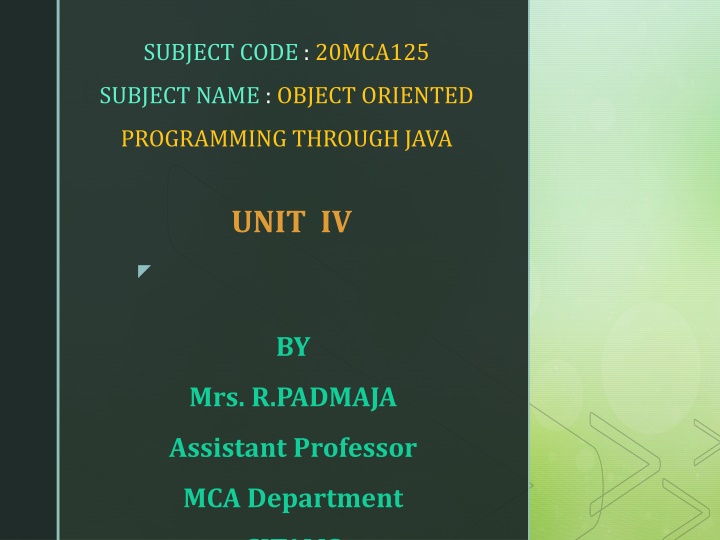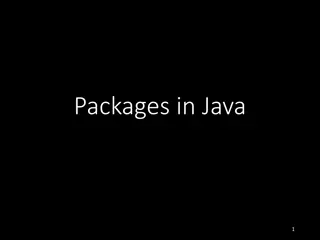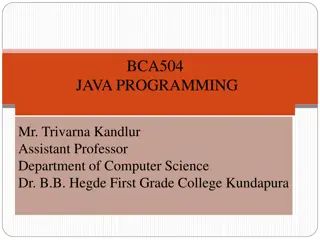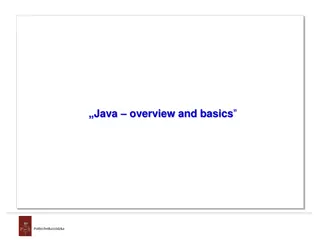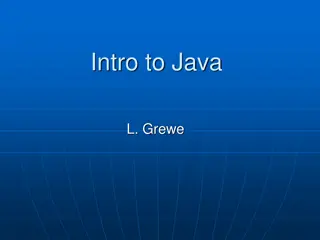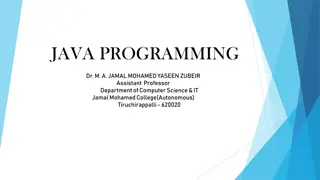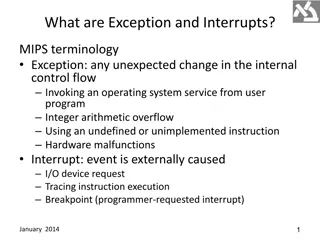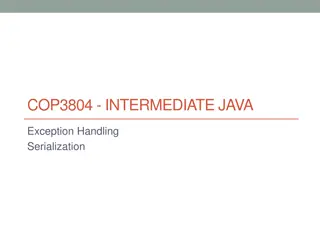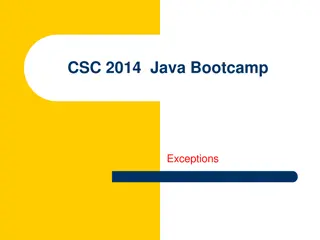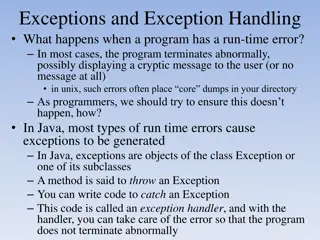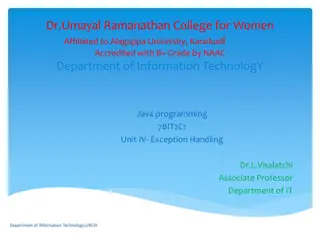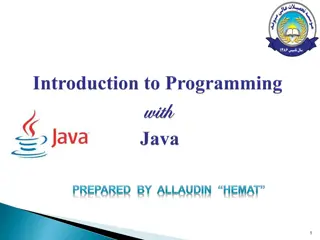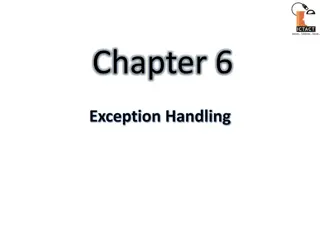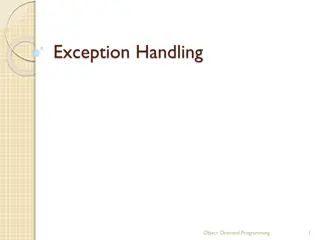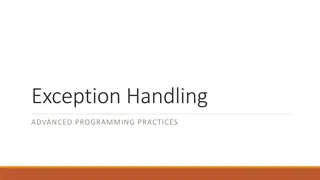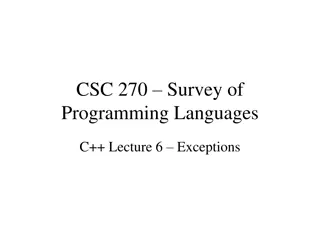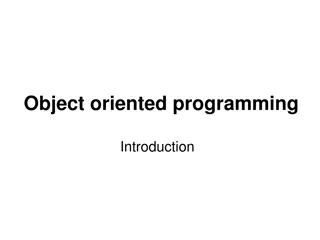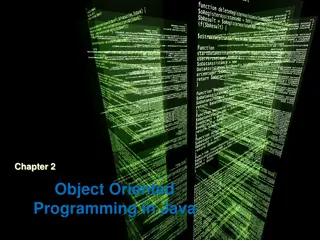Object Oriented Programming Through Java - Exception Handling Fundamentals
Exception handling in Java involves addressing errors that occur during program execution, such as compile-time errors, run-time errors, and logical errors. Learn about the fundamentals of exception handling, types of exceptions, handling techniques, and more in this unit by Mrs. R. Padmaja.
Uploaded on Mar 03, 2025 | 1 Views
Download Presentation

Please find below an Image/Link to download the presentation.
The content on the website is provided AS IS for your information and personal use only. It may not be sold, licensed, or shared on other websites without obtaining consent from the author.If you encounter any issues during the download, it is possible that the publisher has removed the file from their server.
You are allowed to download the files provided on this website for personal or commercial use, subject to the condition that they are used lawfully. All files are the property of their respective owners.
The content on the website is provided AS IS for your information and personal use only. It may not be sold, licensed, or shared on other websites without obtaining consent from the author.
E N D
Presentation Transcript
SUBJECT CODE : 20MCA125 SUBJECT NAME : OBJECT ORIENTED PROGRAMMING THROUGH JAVA UNIT IV BY Mrs. R.PADMAJA Assistant Professor MCA Department SITAMS
UNIT IV UNIT IV- - EXCEPTION HANDLING, MULTITHREADING AND APPLETS EXCEPTION HANDLING, MULTITHREADING AND APPLETS 1) Exception Handling Fundamentals 2) Exception Types 3) Uncaught Exception 4) Using try and catch 5) Multiple Catch Clauses 6) Nested try Statements 7) Throw 8) Throws 9) Finally 10) Java s Built-in Exception 11) Creating your Own Exception Subclasses R.Padmaja, Asst.Professor, SITAMS
INTRODUCTION Java Errors are classified into 3 types 1) Compile -Time Errors 2) Run -Time Errors 3) Logical Errors 1 1) ) Compile Compile- -Time Time Errors Errors Errors occurred at Compile Time are called Compile Time Errors Syntax Errors are detected at Compile Time. These These are are Syntactical Syntactical Errors Errors found a a program program fails fails to to compile compile. . For Example, forgetting a semicolon at the end of a Java statement, or writing a statement without proper syntax will result in compile-time error. Detecting and Correcting compile-time errors is easy as the Java Compiler displays the list of errors with the line numbers along with their description found in in the the code, code, due due to to which which
2) 2) Run Time Errors Run Time Errors Errors occurred at Run Time Run Time are called Run Time Errors Run time errors are not detected by the java compiler java compiler. It is the JVM which detects it while the program is running. Semantic Errors Semantic Errors like division by zero, Index out of Bound are detected by JVM at runtime. 3) 3) Logical Errors Logical Errors These errors are due to the mistakes made by the programmer. It will not be detected by a compiler compiler nor nor by by the the JVM JVM. . Errors may be due to wrong idea or concept used by a programmer while coding.
1) EXCEPTION HANDLING FUNDAMENTALS EXCEPTION HANDLING FUNDAMENTALS An Exception is a Run Run Time Time Error Error (or) An exception is abnormal abnormal condition condition that arises in a code sequence at the run run time time. . When the jvm encounter an Run Run Time Time Error Error such as Division Division by by zero zero, JVM creates an object to the Corresponding Class and throws it. If the Programmer does not catch the thrown object and handles properly, the the interpreter interpreter will will display display an an error error message message and and the the program program gets gets terminated terminated abnormally abnormally. In In order order to to stop stop abnormal abnormal termination termination of of the the program program and and to to fix fix the the error, error, exceptions exceptions should should be be caught caught and and handled handled. .
1) EXCEPTION HANDLING FUNDAMENTALS EXCEPTION HANDLING FUNDAMENTALS Java exception handling is managed via five keywords Try Catch Throw Throws Finally Statements that need to be monitored for exceptions should be placed within a a try try block If an exception occurs within the try block, it is thrown and Your code can catch this exception using catch catch block and handles it in some rational manner.
1) EXCEPTION HANDLING FUNDAMENTALS EXCEPTION HANDLING FUNDAMENTALS System generated exception are automatically thrown by the jvm. To manually throw an exception, use the keyword throw throw. Any exception that is thrown out of method must be specified as such by a throws throws clause. Any code that obsolutely must be executed after a try block completes is put in a finally finally block.
1) EXCEPTION HANDLING FUNDAMENTALS EXCEPTION HANDLING FUNDAMENTALS Java supplies several built in exception types that match the various sorts of run time error that can be generated. RUNTIME RUNTIME ERROR ERROR Corresponding Corresponding Built Built in in Exception Exception Dividing an Integer by Zero ArithmeticException Accessing an element that is out of bound Trying to store a value into an array of an incompatible class or type ArrayIndexOutOfBoundsException ArrayStoreException
1) EXCEPTION HANDLING FUNDAMENTALS EXCEPTION HANDLING FUNDAMENTALS class ExceptionDemo { Public static void main(String args[]) { int d,a; d=0; a=42/d; System.out.println( statement 1 ); } } Since Division by zero abnormal condition is raised here, JVM creates object to Arthimetic Exception class and throws it to the program and program will get terminated Statement will not be executed ArithmeticException ArithmeticException raised and thrown but nobody to catch and handle . So, the default raised and thrown but nobody to catch and handle . So, the default handler catches and terminates the program. handler catches and terminates the program. OutPut: Z:>javac ExceptionDemo.java Z:>java ExceptionDemo Exception in thread "main" Exception in thread "main" java.lang.ArithmeticException java.lang.ArithmeticException: / by zero at ExceptionDemo.main ExceptionDemo.main(ExceptionDemo.java:7) (ExceptionDemo.java:7) : / by zero at
1) EXCEPTION HANDLING FUNDAMENTALS EXCEPTION HANDLING FUNDAMENTALS class ExceptionDemo { Public static void main(String args[]) { int d,a; try { } catch(ArthimeticException ae) { } System.out.println( statement 1 ); } } Since Division by zero abnormal condition is raised here, JVM creates object to Arthimetic Exception class and throws it to the program d=0; a=42/d; Thrown Object is caught System.out.println( Division by Zero Occurred ); Exception is handled This Statement will be executed By handling Exception, we are able to By handling Exception, we are able to fix Errors Terminate Terminate fix Errors and and stops abnormal stops abnormal
1) EXCEPTION HANDLING FUNDAMENTALS EXCEPTION HANDLING FUNDAMENTALS
1) EXCEPTION HANDLING FUNDAMENTALS EXCEPTION HANDLING FUNDAMENTALS Once an exception is thrown, program control transfers out of the try block into the catch block. Once the catch statement has executed program control continues with in the next line in the program following the entire try/catch block mechanism.
1) EXCEPTION HANDLING FUNDAMENTALS EXCEPTION HANDLING FUNDAMENTALS General Form Of An Exception Handling Block General Form Of An Exception Handling Block try try { { Block of code to Block of code to moniter } } Catch(Exception type1 Catch(Exception type1 exod exod) ) { { Exception handler for Exception type1 Exception handler for Exception type1 } } Catch(Exception type2 Catch(Exception type2 exob exob) ) { { Exception handler for Exception tpye2 Exception handler for Exception tpye2 } } Finally Finally { { Block of code to be executed after Block of code to be executed after Try block ends Try block ends } } moniter for errors for errors
2) EXCEPTION TYPES EXCEPTION TYPES
2) EXCEPTION TYPES EXCEPTION TYPES
3) UNCAUGHT EXCEPTION UNCAUGHT EXCEPTION class ExceptionDemo { Public static void main(String args[]) { int d,a; d=0; a=42/d; System.out.println( statement 1 ); } } ArithmeticException ArithmeticException raised and thrown but nobody to catch and handle . So, the default raised and thrown but nobody to catch and handle . So, the default handler catches and terminates the program. handler catches and terminates the program. OutPut: Z:>javac ExceptionDemo.java Z:>java ExceptionDemo Exception in thread "main" Exception in thread "main" java.lang.ArithmeticException java.lang.ArithmeticException: / by zero at ExceptionDemo.main ExceptionDemo.main(ExceptionDemo.java:7) (ExceptionDemo.java:7) : / by zero at
3) UNCAUGHT EXCEPTION UNCAUGHT EXCEPTION Any Exception that is not caught by the program will ultimately be processed by the default handler. The Default Handler displays a string describing the exception, prints a stack trace from the point at which the exception occurred, and terminates the program. Here is the Exception generated when the above example is executed java.lang.ArithmeticException: /by Zero at Exc0.main(Exc0.java:4) the class name, Exc0; the method name, main; the filename,Exc0.java;and the line number,4, are all included in the simple stack trace.
Using Try and Catch Using Try and Catch class ExceptionDemo { Public static void main(String args[]) { int d,a; try { } catch(ArthimeticException ae) { } System.out.println( statement 1 ); } } Since Division by zero abnormal condition is raised here, JVM creates object to Arthimetic Exception class and throws it to the program d=0; a=42/d; Thrown Object is caught System.out.println( Division by Zero Occurred ); Exception is handled This Statement will be executed By handling Exception, we are able to By handling Exception, we are able to fix Errors Terminate Terminate fix Errors and and stops abnormal stops abnormal
1) EXCEPTION HANDLING FUNDAMENTALS EXCEPTION HANDLING FUNDAMENTALS
MULTITHREADING PROGRAMMING MULTITHREADING PROGRAMMING 1) Introduction 2) Thread States 3) Creating a Multiple Threads 4) Thread Priorities
1) 1) INTRODUCTION INTRODUCTION Java is a multithreaded programming language means - we can develop multithreaded programs using Java. A multithreaded program contains two or more parts that can run concurrently and each part can handle different task at the same time making optimal use of the available resources specially the processor. By definition multitasking is when multiple processes share common processing resources such as a CPU. Multithreading extends the idea of multitasking into applications where you can subdivide specific operations within a single application into individual threads. Each of the threads can run in parallel. The OS divides processing time not only among different applications, but also among each thread within an application
2) 2) Thread states Thread states During the life time of a thread there are many states it can enter. They are A. NewBorn state B. Runnable state Running State C. D. Blocked state E. Dead state A thread is always in any one of these five states.It can move from one state to another via a variety of ways as shown below
2) 2) Thread states Thread states
2) 2) Thread states Thread states A. New Born state : when we create a thread object, the thread is born and is said to be in new born state. The thread is not yet scheduled for running .At this state, we can do only one of the following things with it. Schedule it for running using start() method. Kill it using stop() method. If scheduled ,it moves to the runnable state.
2) 2) Thread states Thread states B. Runnable State: The runnable state means that the thread is ready for execution and is waiting for availability of the processor .i.e the thread has joined the queue of threads that are waiting for execution. If all threads have equal priority, then they are given time slots for execution in Round Robin fashion,i.e FCFS manner. The thread that relinguishes control joins the queue at the end & again waits for its turn
2) 2) Thread states Thread states C. Running State: Running means that the processor has given its time to the thread for its execution. The thread runs until it relinguishes its control in one of the following situations. 1) It has been suspended using suspend(). a suspended thread can be received by using the resume() method. 2) It has been made wait by using wait() method A thread that is waiting will get resumed after notify() method 3) It has been slept for a t seconds A thread will get invoked after t second
2) 2) Thread states Thread states Example :
2) 2) Thread states Thread states D. Blocked state: A thread can also be temporarily suspended or blocked from entering into the runnable and subsequently running state by using either of the following thread methods. Sleep() // blocked for a specified time Suspended() // blocked until further orders Wait() // blocked until certain condition occurs. These methods cause the thread to go into the blocked sate. The thread will return to runnable state when the specified time is elapsed in the case of sleep(),the resume() method is invoked in case of suspend(),and notify() method is called in case of wait(). E. Dead State:
2) 2) Thread states Thread states E. Dead State Every thread has a life cycle . A running thread ends its life when it has completed executing its run().it is natural death. However, we can kill it by using stop message to it at any stage.Thus causing premature death to it.
3) Creating a Multiple Threads 3) Creating a Multiple Threads Creating threads in java is simple. Threads in java can be created in two ways 1) By extending the thread class. 2) By implementing the runnable interface. 1) Creating threads by extending the thread class: Define a class that extends thread class and override its run()with the code required by the thread. Steps to create thread by extending thread class are a) Declaring the class b) Implementing the run() method. c) Starting New Thread.
3) Creating a Multiple Threads 3) Creating a Multiple Threads a)Declaring the class: declare the class by extending the thread class as: Class MyThread extends Thread { ---------- ---------- } b)Implementing the run() method: the run method is the heart and soul of any thread. We have to override this method in order to implement the code to be executed by our thread. It makes up the entire body of a thread and is the only method in which the threads behavior can be implemented. The basic implementation of run() will look like public void run() { Thread code } When we start new thread ,java calls the threads run() method.
3) Creating a Multiple Threads 3) Creating a Multiple Threads C )Starting New Thread: create a thread object and call the start() method to initiate the thread execution. To create and run an instance of our thread class, we must write the following: MyThread t1=new MyThread(); T1.start(); The first line instantiates a new object of class MyThread. The second line calls start() causing the thread to move into runnable state. Then, the java runtime will schedule the thread to run by invoking its run().Hence the thread is said to be in Running state.
3) Creating a Multiple Threads 3) Creating a Multiple Threads
3) Creating a Multiple Threads 3) Creating a Multiple Threads
3) Creating a Multiple Threads 3) Creating a Multiple Threads 2) Creating Thread using Runnable Interface A) Create a Class that implements Runnable Interface B) override run() method C) create a thread by passing an object to the implementation class of runnable interface
3) Creating a Multiple Threads 3) Creating a Multiple Threads
3) Creating a Multiple Threads 3) Creating a Multiple Threads
3) Creating a Multiple Threads 3) Creating a Multiple Threads
3) Creating a Multiple Threads 3) Creating a Multiple Threads Among two ways of creating threads i.e 1) By extending Thread class 2) Implements Runnable interface if you will not be over riding any of threads methods other than run() method ,it is probably best simply to implement runnable. In short,if we want to override only run() method better to use Runnable interface . If it requires to extend other than Thread class, we have no choice but to implement the runnable interface since java classes cannot have two super class.
4) THREAD PRIORITIES 4) THREAD PRIORITIES In java, each thread is assigned a priority,which affects the order in which it is scheduled for running. The thread of the same priority are given equal treatment by java scheduler and therefore they share the processor on a first come, first serve basis. Java permits us to set and get priority of a thread using setPriority() and getPriority() as follows ThreadName.setPriority(int Number) ThreadName.getPriority() Thread class constants are MIN_PRIORITY=1 MAX_PRIORITY=10 NORM_PRIORITY=5 NORM_PRIORIty is the default priority.
3) THREAD PRIORITIES 3) THREAD PRIORITIES Java run time system usually applies one of the two following strategies Preemptive scheduling:if the thread has a higher priority then the 1) current running thread leaves runnable state and higher priority enter to runnable state. Time-sliced(Round robin):A running thread is allowed to be execute 2) for the fixed time, after completion of time , current thread indicates to the another thread to enter it in the runnable state
3) THREAD PRIORITIES 3) THREAD PRIORITIES
3) THREAD PRIORITIES 3) THREAD PRIORITIES
APPLETS APPLETS 1)Applets 2)How Applets differ from Applications 3)Building Applet Code 4)Applet Life Cycle 5)Designing a web page 6)Applet tag, 7)Adding Applet to HTML File, 8)Running the Applet. An applet is a Java program that runs in a Web browser.
2) How Applets differ from Applications 2) How Applets differ from Applications Application Applet Applications are stand-alone programs that can be run independently without having to use a web browser. Applets are small Java programs that are designed to be included in a HTML web document. They require a Java-enabled browser for execution. Java Applications can read ,write or access the file from local file system Applets cannot read ,write or access the file from local file system It does not require a main method() for its execution. It requires a main method() for its execution. Applications can run programs from the local system. Applets cannot run programs from the local machine. An application program is used to perform some task directly for the user. An applet program is used to perform small tasks or part of it. Java Applications programs can access all the resources of the system including data and information on that system Applets cannot access or modify any resource on the system except only the browser specific services Applets are restricted rom using libraries from other languages Applications are not restricted rom using libraries from other languages
Applet Life Cycle Applet Life Cycle Applet is a java program executed on web browser Applet is a special type of program that is embedded in the webpage to generate the dynamic content. It runs inside the browser and works at client side. The life cycle of an applet is as shown in the figure below:
As shown in the above diagram, the life cycle of an applet starts with init() method and ends with destroy() method. Other life cycle methods are start(), stop() and paint(). The methods to execute only once in the applet life cycle are init() and destroy(). Other methods execute multiple times. 1) init(): The init() method is the first method to execute when the applet is executed. Variable declaration and initialization operations are performed in this method. 2) start(): The start() method contains the actual code of the applet that should run. The start() method executes immediately after the init() method. It also executes whenever the applet is restored, maximized or moving from one tab to another tab in the browser. 3) stop(): The stop() method stops the execution of the applet. The stop() method executes when the applet is minimized or when moving from one tab to another in the browser.
4) destroy(): The destroy() method executes when the applet window is closed or when the tab containing the webpage is closed. stop() method executes just before when destroy() method is invoked. The destroy() method removes the applet object from memory. 5) paint(): The paint() method is used to redraw the output on the applet display area. The paint() method executes after the execution of start() method and whenever the applet or browser is resized.
How to run an Applet? There are two ways to run an applet 1.By html file. 2.By appletViewer tool (for testing purpose).
